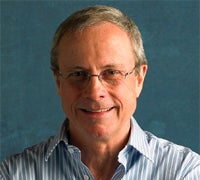 |
Productivity guru David Allen Source: Office 2.0 |
SAN FRANCISCO — Collaboration, which is at the heart of the new office-productivity applications hitting the market known as Office 2.0 tools, will make it much easier to get things done, management consultant David Allen said in his keynote speech at the Office 2.0 conference today.
As these tools develop, they will take users to the next level of efficiency, Allen said. “Ultimately you’ll able to go to the wall screen and open up your address book,” Allen said. “It’ll be like the Harry Potter movies.”
However, being productive with Office 2.0 technologies will still require self-management, which is the basis of Allen’s system of getting things done, known as GTD to his fans. The acronym GTD came from the title of his first book, Getting Things Done: the Art of Stress-Free Productivity. Lifehacker, a popular blog covering productivity, calls Allen its “patron saint.”
Collaborative tools go beyond those that “just let you slice and dice information” such as Google (NASDAQ: GOOG) Maps, which Allen said does not make the cut. “Google Maps is cool, but all it lets you do is push the paradigm a little bit from what you can do with paper maps,” he explained.
Allen prefers tools that cause him to have an idea he would not otherwise have had. Mind-mapping technology is “an edge of the next level” because it lets him play around with information and develop new ideas, he said.
That’s because GTD includes capturing anything and everything that gets a user’s attention, organizing reminders and information in the most streamlined way and frequent reviews of commitments. A mind map is a diagram used to represent words, ideas and tasks around a central idea, and mind maps are used to generate and visualize ideas. Several vendors, including Mindjet, FreeMind, and WikkaWiki offer mind-mapping software.
Ultimately, mind mapping, combined with physical movement and holograms, “will be a big shift” in technology, Allen said. “If while walking I said ‘Computer: Fun New York City Ballet’ and the computer knows fun is one of my categories and ballets in New York are of interest, then whenever my assistant John keys in “New York,” the computer comes up with information on ballets and ticket information,” he explained. “That’s the kind of enabling tools which will, I think, shift the paradigm.”
Taking back your life
Still, unless users implement control and perspective they will not be able to fully exploit the new collaborative tools, Allen said. “You need control, and you need the right perspective,” he added.
Control “is cooperation with intention,” he continued. “It’s not where you don’t change anything,” Allen explained. “And right perspective means users make sure they focus on the right things. It’s about taking back your life,” Allen said.
Users should begin with control. “If your ship is sinking, you don’t care where you point it, you have to plug up the leak,” Allen said. “Then you must have perspective to make sure you’re pointing it in the right direction and not heading towards a coral reef. But it’s hard to focus when you’re out of control.”
Once users have control and perspective, they will be able to deal with the flood of information that will result from using the new collaborative tools. “It has nothing to do with the volume of data you’re dealing with,” Allen explained. “It’s all about rapid action, doing something then switching rapidly to the next thing without keeping on thinking about the previous thing.”


